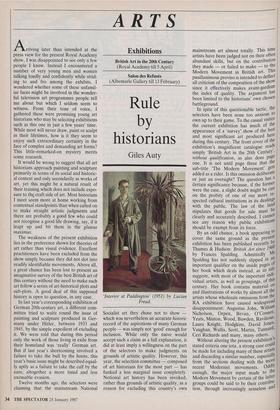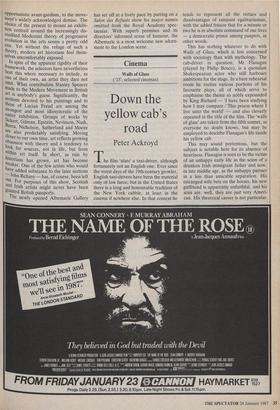ARTS
Exhibitions
British Art in the 20th Century (Royal Academy till 5 April) Salon des Refus6s (Albemarle Gallery till 13 February)
Rule by historians
Giles Auty
Arriving later than intended at the press view for the present Royal Academy show, I was disappointed to see only a few people I knew. Instead I encountered a number of very young men and women talking loudly and confidently while strid- ing to and fro among the exhibits. I wondered whether some of these unfamil- iar faces might be involved in the wonder- ful television art programmes people tell me about but which I seldom seem to witness. From their tone of voice, I gathered these were promising young art historians who may be selecting exhibitions such as this one in just a few years' time. While most will never draw, paint or sculpt in their lifetimes, how is it they seem to enjoy such extraordinary certainty in the face of complex and demanding art forms? This little-remarked-on mystery merits some research.
It would be wrong to suggest that all art historians approach painting and sculpture primarily in terms of its social and historic- al context and only secondarily as works of art, yet this might be a natural result of their training which does not include expo- sure to thq craft side of art. Most historians I meet seem more at home working from contextual standpoints than when called on to make straight artistic judgments and there are probably a gobd few who could not recognise a good life drawing, say, if it leapt up and bit them in the gluteus maximus.
The weakness of the present exhibition lies in the preference shown for theories of art rather than visual evidence. Excellent practitioners have been excluded from the show simply because they did not slot into readily identifiable movements. Above all, a great chance has been lost to present an imaginative survey of the best British art of this century without the need to make such art follow a series of art-historical plots and sub-plots. A good deal of this supposed history is open to question, in any case.
In last year's corresponding exhibition of German 20th-century art, a different com- mittee tried to waltz round the issue of painting and sculpture produced in Ger- many under Hitler, between 1933 and 1945, by the simple expedient of excluding it. We were told that during this period only the work of those living in exile from their homeland was 'really' German art. But if last year's shortcoming involved a failure to take the bull by the horns, this year's basic issue might be described equal- ly aptly as a failure to take the calf by the ears; altogether a more timid and less excusable evasion.
Twelve months ago, the selectors were claiming that the mainstream National Paddington' (1951) by Lucian Freud.
Socialist art they chose not to show which was nevertheless an accurate historic record of the aspirations of many German people — was simply not 'good' enough for inclusion. While only the naive would accept such a claim as a full explanation, it did at least imply a willingness on the part of the selectors to make judgments on grounds of artistic quality. However, this year, the selection committee — composed of art historians for the most part — has funked a less marginal issue completely. Notional art history has been invoked, rather than grounds of artistic quality, as a reason for excluding this country's own mainstream art almost totally. This time artists have been judged not on their often abundant skills, but on the contribution they made — or failed to make — to the Modern Movement in British art. This pusillanimous proviso is intended to deflect all criticism of the composition of the show since it effectively makes avant-gardism the index of quality. The argument has been limited to the historians' own chosen battleground. In spite of this questionable tactic, the selectors have been none too anxious to own up to their game. To the casual visitor the current exhibition has much of the appearance of a 'survey' show of the best and most significant art produced here during this century. The front cover of the exhibition's magnificent catalogue reads simply 'British Art in the 20th Century without qualification, as also does page one. It is not until page three that the sub-title 'The Modern Movement' gets added as a rider. Is this omission deliberate or just an oversight? The question has a Certain significance because, if the former were the case, a slight doubt might be cast on the probity of one of our more re- spected cultural institutions in its dealings with the public. The law of the land stipulates that goods for sale must be clearly and accurately described. I cannot see any reason why public exhibitions should be exempt from its force. By an odd chance, a book appearing to cover the same ground as the present exhibition has been published recently by Thames & Hudson: British Art since 190° by Frances Spalding. Admittedly Ms Spalding has not suddenly slipped in an important qualifier on the inside pages .of her book which deals instead, as its tal! suggests, with most of the important indi- vidual artists, as well as groupings, of this century. Her book contains material on and illustrations of works by almost all the artists whose wholesale omissions from the RA exhibition have caused widespread disappointment: Augustus John, William Nicholson, Orpen, Bevan, O'Connor, Yeats, Minton, Wood, Bawden, Ravilious, Laura Knight, Hodgkins, David Jones, Vaughan, Wallis, Scott, Martin, Tunnard, Ceri Richards and many, many others. , Without altering the present exhibition 5 stated criteria one iota, a strong case could be made for including many of these artists and discarding a similar number, especially from the sections dealing with the more recent Modernist movements. oddly enough, the major input made to the Modern Movement by certain of the latter groups could be said to be their contribu- tion, through increasingly senseless and oPportunistic avant-gardism, to the move- ment's widely acknowledged demise. The choice of the present to mount an exhibi- tion centred around the increasingly dis- credited Modernist theory of progressive evolution in the arts seems a pretty odd one. Yet without the refuge of such a theory, modern art historians feel them- selves uncomfortably exposed. In spite of the apparent rigidity of their framework, the selectors have nevertheless bent this where necessary to include, as one of their own, an artist they dare not omit. What contribution Stanley Spencer made to the Modern Movement in British art is anybody's guess. Significantly, the sections devoted to his paintings and to those of Lucian Freud are among the strongest and most idiosyncratic of the entire exhibition. Groups of works by Sicken, Gilman, Epstein, Nevinson, Nash, Barra, Nicholson, Sutherland and Moore are also predictably satisfying. Moving closer to our own time, art reflects growing obsession with theory and a tendency to 109k for sources, not in life, but from Within art itself. In short, as rule by historians has grown, art has become Weaker. One of the few artists who would have added substance to the later sections John Bellany — has, of course, been left Out For purposes of this show, Scottish and Irish artists might never have been granted British passports. The newly opened Albemarle Gallery has set off at a lively pace by putting on a Salon des Refuses show for major names omitted froth the Royal Academy spec- tacular. With superb premises and its directors' informed sense of humour, the Albemarle is a most welcome new adorn- ment to the London scene.



















































 Previous page
Previous page